Crucifixion darkness
The crucifixion darkness is an episode in three of the canonical gospels in which the sky becomes dark in daytime during the crucifixion of Jesus.
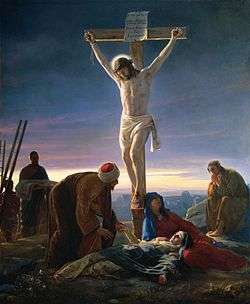
Christian apologist Tertullian in AD 197 considered this not an eclipse but a portent, which he claimed was recorded in Roman archives. The third-century Christian commentator Origen offered two natural explanations for the darkness: that it might have been the eclipse (presumably of AD 29) described by Phlegon of Tralles, or that it might have been clouds.
Modern scholars have found no contemporary references to the darkness outside the New Testament, but have found mention of it in ancient writings that reference sources lost to us today, such as those of the Greek historian Thallus.[1] Some scholars favour natural explanations such as a khamsin (sand storm). Others note that similar accounts were associated in ancient times and in the Old Testament with the deaths of notable figures, and see the phenomenon as a literary invention that attempts to convey a sense of the power of Jesus in the face of death, or a sign of God's displeasure with the Jewish people.
Biblical account
| Events in the |
| Life of Jesus according to the canonical gospels |
|---|
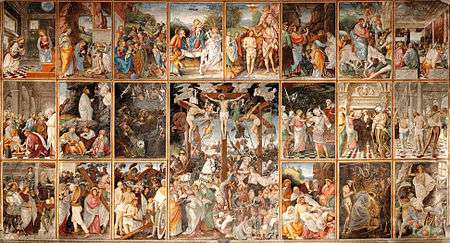 |
|
In rest of the NT |
|
Portals: |
| Part of a series on |
| Death and Resurrection of Jesus |
|---|
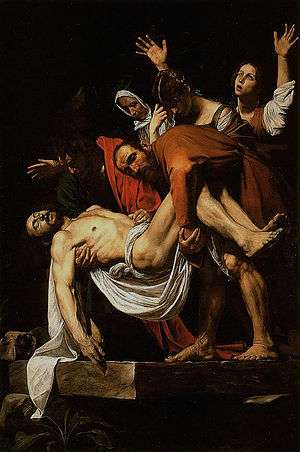 |
|
|
Visions of Jesus
|
|
Empty tomb fringe theories |
|
Related |
|
Portals: |
The oldest biblical reference to the crucifixion darkness is found in the Gospel of Mark, written around the year 70.[2][3] In its account of the crucifixion, on the eve of Passover, it says that after Jesus was crucified at nine in the morning; darkness fell over all the land, or all the world (Greek: γῆν, translit. gēn can mean either) from around noon ("the sixth hour") until 3 o'clock ("the ninth hour").[4] It adds, immediately after the death of Jesus, that "the curtain of the temple was torn in two, from top to bottom".[5]
The Gospel of Matthew has an almost identical wording: "From noon on, darkness came over the whole land [or, earth] until three in the afternoon."[6] The author includes dramatic details, including an earthquake and the raising of the dead, which were also common motifs in Jewish apocalyptic literature:[7][8] "The earth shook, and the rocks were split. The tombs also were opened, and many bodies of the saints who had fallen asleep were raised."[9]
The Gospel of Luke has none of the details of the Matthew version, mentions the tearing of the temple veil immediately before the death of Jesus,[10] and provides the obscuring of the Sun as the cause of the darkness:[11][12]
It was now about noon, and darkness came over the whole land [or, earth] until three in the afternoon, while the sun's light failed [or, the sun was eclipsed]; and the curtain of the temple was torn in two.[13]
It appears that Luke's Gospel originally explained the event as an eclipse. The majority of manuscripts of the Gospel of Luke have the Greek phrase eskotisthe ho helios ("the sun was darkened"), but the earliest manuscripts say tou heliou eklipontos ("the sun's light failed" or "the sun was in eclipse").[14] This earlier version is likely to have been the original one, amended by later scribes to correct what they assumed was an error, since they knew that an eclipse was impossible during Passover.[15][16] One early Christian commentator even suggested that the text had been deliberately corrupted by opponents of the Church to make it easier to attack.[17]
In the account of the crucifixion given in the Gospel of John[18] there is no mention of darkness, the tearing of the veil, or the raising of the dead.[19]
Later versions
Apocryphal writers
A number of accounts in apocryphal literature built on the accounts of the crucifixion darkness. The Gospel of Peter, probably from the second century, expanded on the canonical gospel accounts in creative ways. As one writer puts it, "accompanying miracles become more fabulous and the apocalyptic portents are more vivid".[20] In this version, the darkness which covers the whole of Judaea leads people to go about with lamps believing it to be night.[21] The fourth century Gospel of Nicodemus describes how Pilate and his wife are disturbed by a report of what had happened, and the Judeans he has summoned tell him it was an ordinary solar eclipse.[22] Another text from the fourth century, the purported Report of Pontius Pilate to Tiberius, claimed the darkness had started at the sixth hour, covered the whole world, and during the subsequent evening the full moon resembled blood for the entire night.[23] In a fifth- or sixth-century text by Pseudo-Dionysius the Areopagite, the author claims to have observed a solar eclipse from Heliopolis at the time of the crucifixion.[24]
Ancient historians
No contemporary references to this darkness have been found outside of the New Testament.[25]
Tertullian, in his Apologeticus of AD 197, referred to the biblical crucifixion darkness and claimed that an independent account of the omen was held in the Roman archives: "And yet, nailed upon the cross, He exhibited many notable signs, by which His death was distinguished from all others. At His own free-will, He with a word dismissed from Him His spirit, anticipating the executioner’s work. In the same hour, too, the light of day was withdrawn, when the sun at the very time was in his meridian blaze. Those who were not aware that this had been predicted about Christ, no doubt thought it an eclipse. You yourselves have the account of the world-portent still in your archives."[26]
In AD 248, the crucifixion darkness story was used by the Christian apologist Origen as an example of the biblical account being supported by non-Christian sources: when the pagan critic Celsus claimed that Jesus could hardly be a God because he had performed no great deeds, Origen responded, in Against Celsus, by recounting the darkness, earthquake and opening of tombs. As proof that the incident had happened, Origen referred to a description by Phlegon of Tralles of an eclipse, accompanied by earthquakes felt in other parts of the Empire during the reign of Tiberius (probably that of AD 29).[27] In his Commentary on Matthew, however, Origen offered a different approach. Answering criticisms that there was no mention of this incident in any of the many non-Christian sources, he insisted that it was local to Palestine, and therefore would have gone unnoticed outside. To suggestions it was merely an eclipse, Origen pointed out that this was impossible and suggested other explanations, such as heavy clouds, drawing only on the accounts given in Matthew and Mark, which make no mention of the Sun.[28]
In the ninth century, the Byzantine historian George Syncellus quoted from the third-century Christian historian Sextus Julius Africanus, who remarked that "Thallos dismisses this darkness as a solar eclipse".[29] It is not known when the chronicler Thallus lived, and it is unclear whether he himself made any reference to the crucifixion.[30]
New World accounts of darkness
In the Huarochirí Manuscript Spanish cleric Francisco de Ávila records
In all the stories and fables of these people I have never been able to make out which came first, or in what order they should be placed, for they are all very ancient traditions. They relate that, a long time ago, the sun disappeared and the world was dark for a space of five days; that the stones knocked one against the other; and that the mortars, which they call mutca, and the pestles called marop, rose against their masters, who were also attacked by their sheep, both those fastened in the houses and those in the fields. This p. 132 may have been the eclipse which occurred when our Redeemer died; but I cannot clearly make this out, for when it was day in that hemisphere it was night here, so that here the eclipse would have taken place at night. The rest of the story consists of lies, for, as these people had no watches, how could they tell that the sun was absent for five days, seeing that we count days by the absence and presence of the sun?
In El señorío de los Incas, the second part of the Chronicle of Peru, Pedro Cieza de León retells stories from the natives regarding Ticiviracocha (Viracocha). It describes a people that existed before the Incas that experienced a period of suffering without light. The people prayed and the sun rose from Lake Titicaca. Toward midday, a white man of great authority and veneration came, turning hills into plains and plains into hills, making fountains from stones, calling him the Maker of all things, originator of them, Father of the sun, and who caused animals and men to be.
In the Book of Mormon which the Latter Day Saint movement claims as scripture, an account is given of a period of darkness in the New World (Western Hemisphere) at the time of Christ's crucifixion and death. It is recorded as three days of darkness after a period of extreme storms and devastation.[31] Following the 3 days of darkness an account is given of the visit of the resurrected Jesus Christ to the inhabitants of the Western Hemisphere.[32]
Explanations
Miracle
Because it was known in ancient and medieval times that a solar eclipse could not take place during Passover (solar eclipses require a new moon while Passover only takes place during a full moon), it was considered a miraculous sign rather than a naturally occurring event.[33] The astronomer Johannes de Sacrobosco wrote, in his The Sphere of the World, "the eclipse was not natural, but, rather, miraculous and contrary to nature".[34] Modern writers who regard this as a miraculous event tend either to see it as operating through a natural phenomenon—such as volcanic dust or heavy cloud cover—or avoid explanation completely.[35] The Reformation Study Bible, for instance, simply states "This was a supernatural darkness."[36]
Natural phenomenon
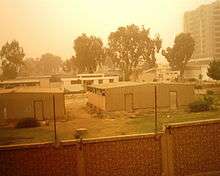
The Gospel of Luke account states "and the sun was darkened"[37] However, the biblical details do not accord with an eclipse: a solar eclipse could not have occurred on or near the Passover, when Jesus was crucified, and would have been too brief to account for three hours of darkness. The maximum possible duration of a total solar eclipse is seven minutes and 31.1 seconds.[38] The only total eclipse visible in Jerusalem in this era occurred late in the year AD 29, on 24 November at 11:05 AM.[39] Around the Sea of Galilee, it would have been visible for just one minute and forty-nine seconds.[40]
Some writers explained the crucifixion darkness in terms of sunstorms, heavy cloud cover, or the aftermath of a volcanic eruption.[41] A popular work of the nineteenth century described it as an 'oppressive gloom' and suggested this was a typical phenomenon related to earthquakes.[42]
In his 2011 book, unlike his 1983 paper, Humphreys accepted that Luke was referring to the Sun, and proposed a khamsin dust storm that tends to occur from March to May and typically obscures the sun for several hours.[43]
Scribal error
In 1983, Colin Humphreys and W. G. Waddington noted that the reference to a solar eclipse is missing in some versions of Luke and argued that the reported sun's darkness could be accounted for by confusion with a partial lunar eclipse that had taken place on 3 April AD 33: lunar eclipses can last much longer than solar ones.[44] In other words, Humphreys and Waddington speculated that the apparent reference in Luke's Gospel to a solar eclipse could have been the result of a scribe wrongly amending Luke's original text. This is a claim that historian David Henige described as "indefensible".[11] Astronomer Bradley E. Schaefer moreover stated that the lunar eclipse would not have been visible in Jerusalem during daylight hours.[45][46]
Literary creation
A common view in modern scholarship is that the account in the synoptic gospels is a literary creation of the gospel writers, intended to heighten the importance of what they saw as a theologically significant event. Burton Mack describes it as a fabrication by the author of the Gospel of Mark,[47] while G. B. Caird and Joseph Fitzmyer conclude that the author did not intend the description to be taken literally.[48][49] W. D. Davies and Dale Allison similarly conclude "It is probable that, without any factual basis, darkness was added in order to wrap the cross in a rich symbol and/or assimilate Jesus to other worthies".[50]
The image of darkness over the land would have been understood by ancient readers as a cosmic sign, a typical element in the description of the death of kings and other major figures by writers such as Philo, Dio Cassius, Virgil, Plutarch and Josephus.[51] Géza Vermes describes the darkness account as "part of the Jewish eschatological imagery of the day of the Lord. It is to be treated as a literary rather than historical phenomenon notwithstanding naive scientists and over-eager television documentary makers, tempted to interpret the account as a datable eclipse of the sun. They would be barking up the wrong tree".[52]
Interpretations
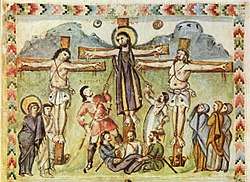
This sequence plays an important part in the gospel's literary narrative. The author of Mark's gospel has been described as operating here "at the peak of his rhetorical and theological powers".[53] One suggestion is that the darkness is a deliberate inversion of the transfiguration;[53] alternatively, Jesus's earlier discourse about a future tribulation mentions the Sun being darkened,[54] and can be seen as foreshadowing this scene.[55] Striking details such as the darkening of the sky and the tearing of the temple veil may be a way of focusing the reader away from the shame and humiliation of the crucifixion; one professor of biblical theology concluded, "it is clear that Jesus is not a humiliated criminal but a man of great significance. His death is therefore not a sign of his weakness but of his power."[56]
When considering the theological meaning of the event, some authors have interpreted the darkness as a period of mourning by the cosmos itself at the death of Jesus.[57] Others have seen it as a sign of God's judgement on the Jewish people, sometimes connecting it with the destruction of the city of Jerusalem in the year 70; or as symbolising shame, fear, or the mental suffering of Jesus.[58] Fitzmyer compares the event to a contemporary description recorded in Josephus' Antiquities of the Jews,[59] which recounts "unlawful acts against the gods, from which we believe the very sun turned away, as if it too were loath to look upon the foul deed".[60]
Many writers have adopted an intertextual approach, looking at earlier texts from which the author of the Mark Gospel may have drawn. In particular, parallels have often been noted between the darkness and the prediction in the Book of Amos of an earthquake in the reign of King Uzziah of Judah: "On that day, says the Lord God, I will make the sun go down at noon, and darken the earth in broad daylight".[61] Particularly in connection with this reference, read as a prophecy of the future, the darkness can be seen as portending the end times.[62]
Another likely literary source is the plague narrative in the Book of Exodus, in which Egypt is covered by darkness for three days.[63] It has been suggested that the author of Matthew's gospel changed the Marcan text slightly to more closely match this source.[64] Commentators have also drawn comparisons with the description of darkness in the Genesis creation narrative,[65] with a prophecy regarding mid-day darkness by Jeremiah,[66] and with an end-times prophecy in the Book of Zechariah.[67][68]
Roman literary sources have also been postulated, namely those on the apotheosis of the mythical king Romulus,[69] and about the death of Julius Caesar.[70]
Notes
- Slick, Matt. "Is there non-biblical evidence of a day of darkness at Christ's death?". CARM. Christian Apologetics and Research Ministry. Retrieved 19 October 2018.
- Witherington (2001), p. 31: 'from 66 to 70, and probably closer to the latter'
- Hooker (1991), p. 8: 'the Gospel is usually dated between AD 65 and 75.'
- Mark 15:33
- Mark 15:38
- Matthew 27:45
- Yieh (2004), p. 65.
- Funk (1998), pp. 129–270, "Matthew".
- Matthew 27:51-54
- Evans (2011), p. 308.
- Henige (2005), p. 150.
- Funk (1998), pp. 267–364, "Luke".
- Luke 23:44-45
- Loader (2002), p. 356.
- Fitzmyer (1985), pp. 1517–1518.
- Wallace (2004).
- Allison (2005), p. 89.
- Barclay (2001), p. 340.
- Broadhead (1994), p. 196.
- Foster (2009), p. 97.
- Roberts, Donaldson & Coxe (1896), Volume IX, "The Gospel of Peter" 5:15, p. 4.
- Barnstone (2005), pp. 351, 368, 374, 378–379, 419.
- Roberts, Donaldson & Coxe (1896), Volume VIII, "The Report of Pontius Pilate", pp. 462–463.
- Parker (1897), pp. 148–149, 182–183.
- Allison (2005), p. 88-96.
- Roberts, Donaldson & Coxe (1896), Volume III, "The Apology" chapter 21, pp. 34–36.
- Roberts, Donaldson & Coxe (1896), Volume IV, "Contra Celsum", Book II, chapter 23 p. 441.
- Allison (2005), pp. 88–89.
- George Syncellus, Chronography, chapter 391.
- Alexander (2005), p. 225.
- Book of Mormon, originally published and translated by Joseph Smith Jun., The Church of Jesus Christ of Latter-Day Saints, 1830
- Book of Mormon, originally published and translated by Joseph Smith Jun., The Church of Jesus Christ of Latter-Day Saints, 1830
- Chambers (1899), pp. 129–130.
- Bartlett (2008), pp. 68–69.
- Allison (2005), pp. 68–69.
- Sproul (2010), comment on Luke 23:44.
- Luke 23:45.
- Meeus (2003).
- Espenak, "Total Solar Eclipse of 0029 Nov 24".
- Kidger, Mark (October 18, 1999). The Star of Bethlehem. Princeton University Press. pp. 70–71. ISBN 0-691-05823-7.
- Brown (1994), p. 1040.
- Charles Ellicott, A New Testament commentary for English readers, 1878, page 176.
- Humphreys (2011), p. 84.
- Humphreys & Waddington (1985).
- Schaefer (1990).
- Schaefer (1991).
- Mack (1988), p. 296, 'This is the earliest account there is about the crucifixion of Jesus. It is a Markan fabrication'
- Caird (1980), p. 186.
- Fitzmyer (1985), p. 1513.
- Davies & Allison (1997), p. 623.
- Garland (1999), p. 264.
- Vermes (2005), pp. 108–109.
- Black (2005), p. 42.
- Mark 13:24
- Healy (2008), p. 319.
- Winn (2008), p. 133.
- Donahue (2002), pp. 451–452.
- Allison (2005), pp. 97–102.
- Fitzmyer (1985), p. 1518.
- Josephus, Antiquities, Book XIV 12:3 (text at Wikisource).
- Amos 8:8-9
- Allison (2005), pp. 100–101.
- Exodus 10:22
- Allison (2005), pp. 182–83.
- Genesis 1:2
- Jeremiah 15:9
- Zechariah 14:6-7
- Allison (2005), pp. 83–84.
- Carrier (2014), pp. 319–58, 225–229.
- Eickenberg (2015), pp. 1–51, 118–133, also including all of the other Crucifixion miracles.
References
- Books
- Alexander, Loveday (2005). "The Four among pagans". In Bockmuehl, Markus; Hagner, Donald A. (eds.). The Written Gospel. Cambridge University Press. pp. 222–237. ISBN 978-1-139-44572-6.CS1 maint: ref=harv (link)
- Allison, Dale C. (2005). Studies in Matthew: Interpretation Past and Present. Baker Academic. ISBN 978-0-8010-2791-8.CS1 maint: ref=harv (link)
- Barclay, William (2001). The Gospel of John, Volume 1. Westminster John Knox Press. ISBN 978-0-664-23780-6.CS1 maint: ref=harv (link)
- Barnstone, Willis, ed. (2005). "The Gospel of Nicodemus". The Other Bible. HarperCollins. ISBN 978-0-06-081598-1.CS1 maint: ref=harv (link)
- Bartlett, Robert (2008). The Natural and the Supernatural in the Middle Ages. Cambridge University Press. ISBN 978-0-521-87832-6.CS1 maint: ref=harv (link)
- Black, C. Clifton (2005). "The Face is Familiar—I Just Can't Place It". In Gaventa, Beverley Roberts; Miller, Patrick D. (eds.). The Ending of Mark and the Ends of God: Essays in Memory of Donald Harrisville Juel. Westminster John Knox Press. ISBN 978-0-664-22739-5.CS1 maint: ref=harv (link)
- Broadhead, Edwin Keith (1994). Prophet, Son, Messiah: Narrative Form and Function in Mark. Continuum. ISBN 978-1-85075-476-3.CS1 maint: ref=harv (link)
- Brown, Raymond E. (1994). The Death of the Messiah: a Commentary on the Passion Narratives in the Four Gospels. The Anchor Bible Reference Library. Volume 2: From Gethsemane to the Grave. Doubleday. ISBN 978-0-385-19397-9.CS1 maint: ref=harv (link)
- Caird, George Bradford (1980). The language and imagery of the Bible. Westminster Press. ISBN 978-0-664-21378-7.CS1 maint: ref=harv (link)
- Carrier, Richard C. (2014). On the Historicity of Jesus: Why We Might Have Reason for Doubt. Sheffield Phoenix Press. ISBN 978-1-909697-49-2.CS1 maint: ref=harv (link)
- Chambers, George F. (1899). The Story of Eclipses. George Newnes, Ltd.CS1 maint: ref=harv (link)
- Davies, Stevan L. (2004). The Gospel of Thomas and Christian Wisdom. Bardic Press. ISBN 978-0-9745667-4-0.CS1 maint: ref=harv (link)
- Davies, William David; Allison, Dale C. (1997). Matthew: Volume 3. Continuum. ISBN 978-0-567-08518-4.CS1 maint: ref=harv (link)
- Donahue, John R. (2002). The Gospel of Mark. Liturgical Press. ISBN 978-0-8146-5804-8.CS1 maint: ref=harv (link)
- Eickenberg, Arne (2015). Die sechste Stunde: Synopsen zum historischen Ursprung der Wunder und Naturkatastrophen in der Passion Christi. Ludwig. ISBN 978-3-86935-193-3.CS1 maint: ref=harv (link)
- Evans, Craig A. (2011). Luke (Understanding the Bible Commentary Series). Baker Books. ISBN 978-1-4412-3652-4.CS1 maint: ref=harv (link)
- Fitzmyer, Joseph A. (1985). The Gospel According to Luke, X-XXIV. The Anchor Bible Reference Library. Doubleday. ISBN 978-0-300-13981-5.CS1 maint: ref=harv (link)
- Foster, Paul (2009). The Apocryphal Gospels: A Very Short Introduction. Oxford University Press. ISBN 978-0-19-157895-3.CS1 maint: ref=harv (link)
- Funk, Robert Walter (1998). The acts of Jesus: the search for the authentic deeds of Jesus. HarperSanFrancisco. ISBN 978-0-06-062978-6.CS1 maint: ref=harv (link)
- Garland, David E. (1999). Reading Matthew: A Literary and Theological Commentary on the First Gospel. Smyth & Helwys Publishing. ISBN 978-1-57312-274-0.CS1 maint: ref=harv (link)
- Harrington, Daniel J. (1991). The Gospel of Matthew. Liturgical Press. ISBN 978-0-8146-5803-1.CS1 maint: ref=harv (link)
- Healy, Mary (2008). The Gospel of Mark. Baker Academic. ISBN 978-0-8010-3586-9.CS1 maint: ref=harv (link)
- Henige, David P. (2005). Historical evidence and argument. University of Wisconsin Press. ISBN 978-0-299-21410-4.CS1 maint: ref=harv (link)
- Hooker, Morna (1991). The Gospel According to Saint Mark. Continuum. ISBN 978-0-8264-6039-4.CS1 maint: ref=harv (link)
- Humphreys, Colin J. (2011). The Mystery of the Last Supper: Reconstructing the Final Days of Jesus. Cambridge University Press. ISBN 978-1-139-49631-5.CS1 maint: ref=harv (link)
- Kidger, Mark (1999). The Star of Bethlehem: An Astronomer's View. Princeton University Press. ISBN 978-0-691-05823-8.CS1 maint: ref=harv (link)
- Loader, William (2002). Jesus' Attitude Towards the Law: A Study of the Gospels. W.B. Eerdmans Pub. ISBN 978-0-8028-4903-8.CS1 maint: ref=harv (link)
- Mack, Burton L. (1988). A Myth of Innocence: Mark and Christian Origins. Fortress Press. ISBN 978-1-4514-0466-1.CS1 maint: ref=harv (link)
- Parker, John (1897). "Letter VII. Section II. To Polycarp—Hierarch. & Letter XI. Dionysius to Apollophanes, Philosopher". The Works of Dionysius the Areopagite. Volume One. London: James Parker and Co. ISBN 978-1-4400-9239-8.CS1 maint: ref=harv (link), The Works of Dionysius the Areopagite. Volume Two.
- Roberts, Alexander; Donaldson, James; Coxe, Arthur Cleveland, eds. (1896). The Ante-Nicene Fathers. T&T Clark.CS1 maint: ref=harv (link)
- Sproul, R. C., ed. (2010). The Reformation Study Bible. Ligonier Ministries. ISBN 978-1-59638-207-7.CS1 maint: ref=harv (link)
- Vermes, Géza (2005). The Passion. Penguin. ISBN 978-0-14-102132-4.CS1 maint: ref=harv (link)
- Winn, Adam (2008). The Purpose of Mark's Gospel: An Early Christian Response to Roman Imperial Propaganda. Mohr Siebeck. ISBN 978-3-16-149635-6.CS1 maint: ref=harv (link)
- Witherington, Ben (2001). The Gospel of Mark: A Socio-Rhetorical Commentary. Eerdmans Publishing. ISBN 978-0-8028-4503-0.CS1 maint: ref=harv (link)
- Yieh, John Yueh-Han (2004). One Teacher: Jesus' Teaching Role in Matthew's Gospel Report. Walter de Gruyter. ISBN 978-3-11-091333-0.CS1 maint: ref=harv (link)
- Journal articles
- Humphreys, Colin J.; Waddington, W. Graeme (1983). "Dating the Crucifixion". Nature. 306 (5945): 743. Bibcode:1983Natur.306..743H. doi:10.1038/306743a0.CS1 maint: ref=harv (link)
- Humphreys, Colin J.; Waddington, W. Graeme (March 1985). "The Date of the Crucifixion". Journal of the American Scientific Affiliation. 37: 2–10. Archived from the original on 2010-04-08. Retrieved 2013-11-04.CS1 maint: ref=harv (link)
- Meeus, Jean (December 2003). "The maximum possible duration of a total solar eclipse". Journal of the British Astronomical Association. 113 (6): 343–348. Bibcode:2003JBAA..113..343M.CS1 maint: ref=harv (link)
- Schaefer, Bradley E. (March 1990). "Lunar Visibility and the Crucifixion". Quarterly Journal of the Royal Astronomical Society. 31 (1): 53–67. Bibcode:1990QJRAS..31...53S.CS1 maint: ref=harv (link)
- Schaefer, Bradley E. (1991). "Glare and celestial visibility". Publications of the Astronomical Society of the Pacific. 103: 645. Bibcode:1991PASP..103..645S. doi:10.1086/132865.CS1 maint: ref=harv (link)
- Web sites
- Espenak, Fred. "Total Solar Eclipse of 0029 Nov 24" (PDF). NASA Eclipse Web Site. NASA. Retrieved 3 November 2013.CS1 maint: ref=harv (link)
- Wallace, Daniel B. (21 June 2004). "Errors in the Greek Text Behind Modern Translations? The Cases of Matthew 1:7, 10 and Luke 23:45". Biblical Studies Press. Retrieved 3 February 2020.CS1 maint: ref=harv (link)
- Espenak, Fred. "Lunar Eclipses of Historical Interest". NASA Eclipse Web Site. NASA. Retrieved 21 March 2019.CS1 maint: ref=harv (link)